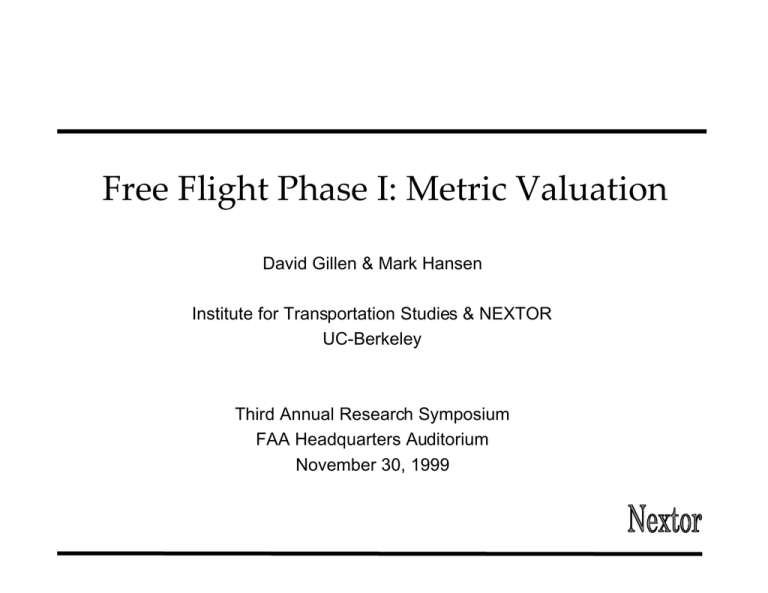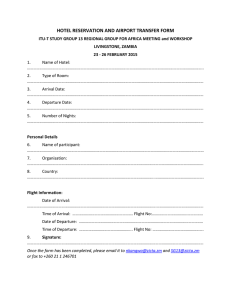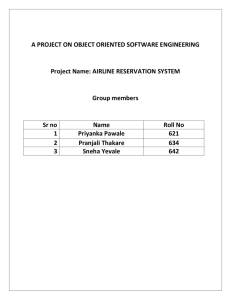Free Flight Phase I: Metric Valuation
advertisement

Free Flight Phase I: Metric Valuation David Gillen & Mark Hansen Institute for Transportation Studies & NEXTOR UC-Berkeley Third Annual Research Symposium FAA Headquarters Auditorium November 30, 1999 Components of FFP1 • • • • • URET pFAST TMA SMA CDM - User request evaluation Tool - Enroute Passive final approach Spacing Tool - Terminal Traffic Management advisor - Enroute, Terminal Surface Movement Advisor - Terminal Collaborative decision-Making with Airline Ops center - Pre flight, Enroute > NAS Status Information(NASSI) > Enhanced ground Delay Program (GDP-E) > Collaborative Routing (CR) Note: each component is a different production function in an integrated environment with affects on different attributes in the set. FFP1 Performance Metrics Key Metrics going across components are: • • • • • • safety - operational errors access - actual arrival rate, number of unused slots, number of cancellations and substitutions delay - average taxi time, average gate delay, average time difference cross meter fix to time cross threshold predictability - variability in taxi times, average fuel usage, variability in flow rates, variability between scheduled and actual times of departure - arrivalpushback flexibility - time spent near or on desired route and/or altitude, number of restrictions eliminated, average flying distance productivity - average throughput per sector per unit time Essential Elements of Performance Measures Four essential elements of performance measures • Set out in simple way the rationale of each measure • Set out the data requirements to obtain meaningful measures • Quantify the overall performance of within the carrier or FAA system • Map the index of performance to a large number of partial measures and contextual/operational factors NAS Performance metrics • • • Quantify by airline by quarter - winter 95 through summer 97 (ASQP) use flight based approach to summarize data use principal component analysis to collapse 7 metrics into smaller number of factors TABLE 1. PERFORMANCE METRIC DEFINITIONS Variable (in Log form) Average Arrival Delay Average Departure Delay Average >15 min Arrival Delay Arrival Delay Variance Departure Delay Variance Unreliability Cancellation Rate Definition Difference between scheduled and actual arrival time, averaged over all flights. Difference between scheduled and actual departure time, averaged over all flights. Sum of all arrival delays in excess of 15 minutes, divided by total number of flights. Variance of the difference between scheduled and actual arrival time. Variance of the difference between scheduled and actual departure time. Proportion of flights with an arrival delay over 15 minutes. Proportion of flights cancelled. Problems or Issues • • • • • • • • • • • What is being maximized - total surplus? How handle trade-offs between different players - Pareto improvements? There is no market in which these services are bought and sold - how do establish value? Is the counterfactual a point or envelope? Measures do not distinguish passengers, cargo and passenger WTP marginal and average distinctions may be important program externalities (synergies) are not considered How are networks included? How are behavioral shifts due to underpricing considered? How is the marginal gain in attributes attributed across programs? Is the correct objective function to minimize the total of (pax/cargo costs+airport costs+FAA infrastructure costs+airline costs) Valuation • Is ‘willingness-to-pay’ the correct concept for establishing value? - is value linked to traditional metrics (RPM, flight time)? • Are improvements in [productive] efficiency sufficient for establishing value? - is this a rent transfer to the airlines? - how is productivity to be measured, TFP? Gross or net? • Will we experience the ‘tragedy of the commons’ with FFP1 with no mechanism to transfer property rights? Approaches • Cost or production functions for airline or airport systems • Stated preference experiments to establish WTP • Linking measures with performance attributes using micro analytics to tie individual metrics to a set of expected benefits. > Reliability delay, variance in flight time missed connections DOC (airline) and demand attribute (passenger valuation) impacts > Predictability fuel burn, variance in stages of flight from push-back to gate increases capital costs and reduces factor efficiency DOC (airline), fleet planning (airline) and demand attribute (passenger valuation) Examples using Delay D P C B2 0 B1 A C UC0(T0 ) UC (T1 ) 1 1 D1(T1 ) D0(T0 ) 0 Q0 Q 1 Governance as Technological Change • • • • • • FFP1 represents a new way of using system capacity without [necessarily] investing in infrastructure (in the traditional sense) As a ‘new technology’ it is similar to the application of ITS in the roadway system To evaluate, and specifically to value, this new technology, we have to value the demand for airline service by passengers and shippers or we have to value the demand for infrastructure by carriers but not both FFP1 will affect airports differently and at different paces (inter-temporal differences) Need to distinguish scale, capacity utilization, factor price and technological change effects Governance can be modeled using transactions cost or contract theory (economics of information in a principal agent setting) Future Research • Develop a set of micro-processes that link metric changes with benefits accruing to airlines, passengers and the aviation system • Establish the linkage between the attribute affected and the management decision for the airline (e.g. if we improve flexibility by allowing airline to select rank order of importance of flights at arriving airport (one with greater number of connecting passengers) how does this impact passenger valuation of service and airline costs • Examine which attribute is relatively more important and which component of FFP1 can provide it most efficiently. • Simulate the expected gains to the aviation system with a realistic integration in FFP1 and identify the gainers and potential losers

